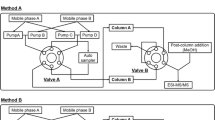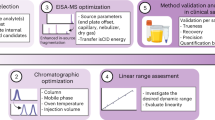Abstract
Oxidized deoxynucleosides are widely used as biomarkers for DNA oxidation and oxidative stress assessment. Although gas chromatography mass spectrometry is widely used for the measurement of multiple DNA lesions, this approach requires complex sample preparation contributing to possible artifactual oxidation. To address these issues, a high performance liquid chromatography (HPLC)-tandem mass spectrometric (LC-MS/MS) method was developed to measure 8-hydroxy-2′-deoxyguanosine (8-OH-dG), 8-hydroxy-2′-deoxyadenosine (8-OH-dA), 2-hydroxy-2′-deoxyadenosine (2-OH-dA), thymidine glycol (TG), and 5-hydroxy-methyl-2′-deoxyuridine (HMDU) in DNA samples with fast sample preparation. In order to selectively monitor the product ions of these precursors with optimum sensitivity for use during quantitative LC-MS/MS analysis, unique and abundant fragment ions had to be identified during MS/MS with collision-induced dissociation (CID). Positive and negative ion electrospray tandem mass spectra with CID were compared for the analysis of these five oxidized deoxynucleosides. The most abundant fragment ions were usually formed by cleavage of the glycosidic bond in both positive and negative ion modes. However, in the negative ion electrospray tandem mass spectra of 8-OH-dG, 2-OH-dA, and 8-OH-dA, cleavage of two bonds within the sugar ring produced abundant S1 type ions with loss of a neutral molecule weighing 90 u, [M − H − 90]−. The signal-to-noise ratio was similar for negative and positive ion electrospray MS/MS except in the case of thymidine glycol where the signal-to-noise was 100 times greater in negative ionization mode. Therefore, negative ion electrospray tandem mass spectrometry with CID would be preferred to positive ion mode for the analysis of sets of oxidized deoxynucleosides that include thymidine glycol. Investigation of the fragmentation pathways indicated some new general rules for the fragmentation of negatively charged oxidized nucleosides. When purine nucleosides contain a hydroxyl group in the C8 position, an S1 type product ion will dominate the product ions due to a six-membered ring hydrogen transfer process. Finally, a new type of fragment ion formed by elimination of a neutral molecule weighing 48 (CO2H4) from the sugar moiety was observed for all three oxidized purine nucleosides.
Similar content being viewed by others
References
Beckman, K. B.; Ames, B. N.J. Biol. Chem. 1997,272, 19633–19636 and references therein.
Dizdaroglu, M.Mutat. Res. 1992,275, 331–342.
Halliwell, B.Free Radic. Res. 1998,29, 469–486.
Wiseman, H.; Halliwell, B.Biochem. J. 1996,313, 17–29 and references therein.
Breen, A. P.; Murphy, J. A.Free Rad. Biol. Med. 1995,18, 1033–1077.
Cadet, J.; Delatour, T.; Douki, T.; Gasparutto, D.; Pouget, J. P.; Ravanat, J. L.; Sauvaigo, S.Mutat. Res. 1999,424, 9–21.
Ames, B. N.Science 1983,221, 1256–1264.
Chen, L.; Bowen, P. E.; Berzy, D.; Aryee, F.; Stacewicz-Sapuntzakis, M.; Riley, R. E.Free Rad. Biol. Med. 1999,26, 695–703.
Halliwell, B.; Dizdaroglu, M.Free Rad. Res. Commun. 1992,16, 75–87.
Podmore, I. D.; Griffiths, H. R.; Herbert, K. E.; Mistry, N.; Mistry, P.; Lunec,J. Nature 1998,392, 559.
Hofer, T.; Möller, L.Chem. Res. Toxicol. 1998,11, 882–887.
Levine, M.; Daruwala, R. C.; Park, J. B.; Rumsey, S. C.; Wang, Y.; Poulsen, H. E.; Weimann, A.; Salonen, J. T.; Nyyssönen, K.; Loft, S.; Cadet, J.; Douki, T.; Ravanat, J. L.Nature 1998,395, 231–232.
Leclercq, L.; Laurent, C.; DePauw, E.Anal. Chem. 1997,69, 1952–1955.
Beland, F. A.; Doerge, D. R.; Churchwell, M. I.; Poirier, M. C.; Schoket, B.; Marques, M. M.Chem. Res. Toxicol. 1999,12, 68–77.
Serrano, J.; Palmeira, C. M.; Wallace, K. B.; Kuehl, D. W.Rapid Commun. Mass Spectrom. 1996,10, 1789–1791.
Ravanat, J. L.; Duretz, B.; Guiller, A.; Douki, T.; Cadet, J.J. Chromatogr. B Biomed. Sci. Appl. 1998,715, 349–356.
Cadet, J.; Odin, F.; Mouret, J. F.; Polverelli, M.; Audic, A.; Giacomoni, P.; Favier, A.; Richard, M.J. Mutat. Res. 1992,275, 343–354.
Douki, T.; Delatour, T.; Bianchini, F.; Cadet,J. Carcinogenesis 1996,17, 347–353.
Rehman, A.; Collis, C. S.; Yang, M.; Kelly, M.; Diplock, A. T.; Halliwell, B.; Rice-Evans, C.Biochem. Biophys. Res. Commun. 1998,246, 293–298.
Saito, T.; Kanai, T.; Fujii, T.Chem. Pharm. Bull. 1993,41, 1850–1852.
Davoll, J.J. Am. Chem. Soc. 1951,73, 3174–3176.
Frenkel, K.; Goldstein, M.; Duker, N.; Teebor, G.Biochemistry 1981,20, 750–754.
Frenkel, K.; Zhong, Z.; Wei, H.; Karkoszka, J.; Patel, U.; Rashid, K.; Georgescu, M.; Solomon, J.J. Anal. Biochem. 1991,196, 126–136.
Wilson, M. S.; McCloskey, J. A.J. Am. Chem. Soc. 1975,97, 3436–3444.
Crow, F. W.; Tomer, K. B.; Gross, M. L.; McCloskey, J. A.; Bergstrom, D. E.Anal. Biochem. 1984,139, 243–262.
Author information
Authors and Affiliations
Corresponding author
Rights and permissions
About this article
Cite this article
Hua, Y., Wainhaus, S.B., Yang, Y. et al. Comparison of negative and positive ion electrospray tandem mass spectrometry for the liquid chromatography tandem mass spectrometry analysis of oxidized deoxynucleosides. J. Am. Soc. Spectrom. 12, 80–87 (2001). https://doi.org/10.1016/S1044-0305(00)00191-4
Received:
Revised:
Accepted:
Issue Date:
DOI: https://doi.org/10.1016/S1044-0305(00)00191-4




